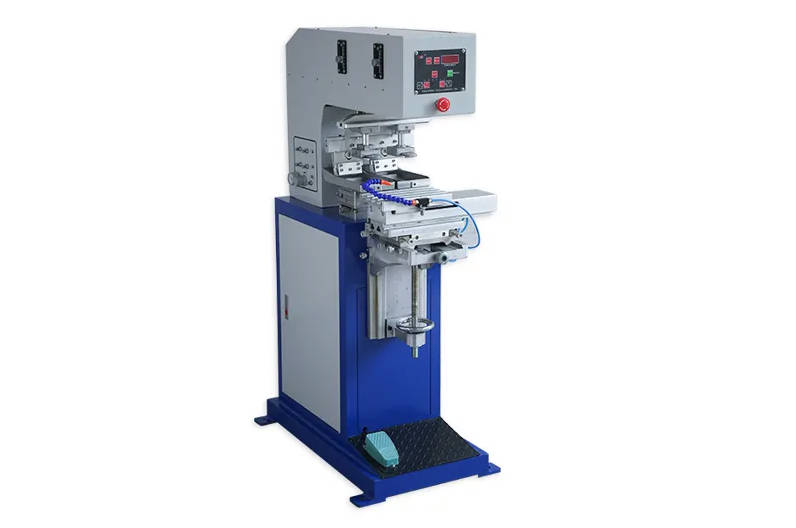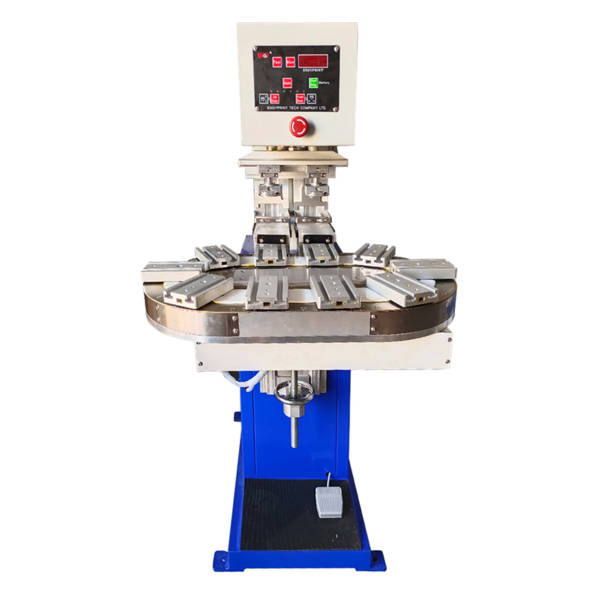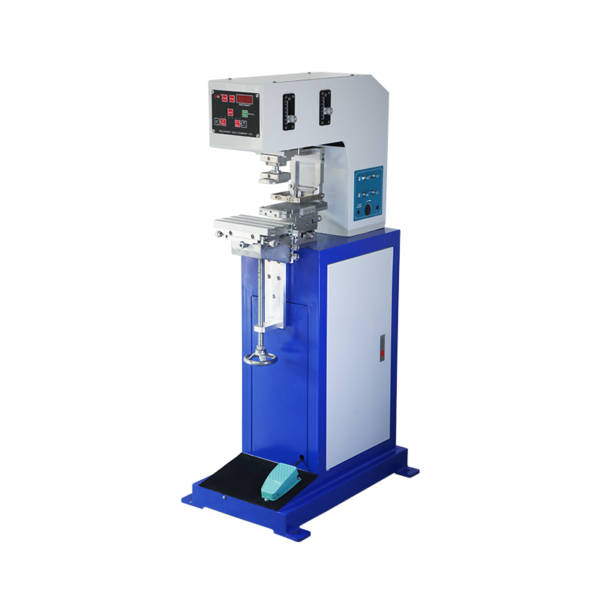I. Introduction
In the dynamic world of product decoration and industrial marking, the pad printing machine stands as a marvel of engineering, capable of transferring intricate designs onto virtually any three-dimensional object, regardless of its shape or surface texture. From delicate medical devices to robust automotive components, these machines enable precision printing where other methods fall short. At its core, a Pad Printing Machine utilizes an indirect gravure process: ink is held in an etched or engraved cliche plate, picked up by a silicone pad, and then transferred to the substrate. The versatility and precision offered by pad printing make it an indispensable technology across numerous industries. Choosing the right machine is not merely a purchase; it’s a strategic investment that critically impacts your production efficiency, print quality, and overall operational success.
The market for Pad Printing Machines is diverse, offering a range of systems from simple manual units to complex, fully automated lines. This guide aims to demystify these options, providing a comprehensive understanding of rotary, inline, and shuttle systems, along with other critical considerations. Our goal is to equip you with the knowledge needed to make an informed decision, ensuring you select a Pad Printing Machine that perfectly aligns with your specific production needs, budget, and quality expectations. We will address common questions and concerns, helping you navigate the complexities of this essential manufacturing technology.

II. Fundamentals of Pad Printing Machines
Before diving into the different system types, it’s crucial to understand the fundamental components and operational parameters that define any Pad Printing Machine.
A. Core Components of a Pad Printing Machine
Regardless of its sophistication, every Pad Printing Machine relies on several key components working in harmony:
- Ink Cup/Ink Tray System (Open vs. Closed Ink Cup):
- Open Ink Tray System: The traditional method where ink is held in an open tray, exposed to air. Requires more frequent solvent addition to prevent drying.
- Closed Ink Cup System: The industry standard for most modern Pad Printing Machines. A sealed cup covers the cliche plate, acting as both an ink reservoir and a doctor blade. This system minimizes solvent evaporation, reduces odor, and offers cleaner operation.
- Cliche Plate Holding: A mechanism to securely hold the etched cliche plate. Precision alignment is vital for accurate print registration.
- Pad Mechanism (Pad Mount/Head): Houses the silicone pad and controls its vertical and horizontal movement (or tilting) during the ink pickup and transfer cycles. The pad’s durometer (hardness), shape, and size are crucial for successful ink transfer.
- Substrate Fixturing/Workholding: A critical component that securely holds the part to be printed in precise alignment. Custom fixtures are often required to accommodate unique part geometries.
- Control System (Pneumatic, Electric, Servo-driven):
- Pneumatic: Uses compressed air for movement, common in smaller or semi-automatic machines, cost-effective.
- Electric: Motors control movement, offering more precise speed and force control than pneumatic.
- Servo-driven: The most advanced control system, offering unparalleled precision, repeatability, and programmability for complex movements and multi-color registration. Ideal for high-end automatic systems.
B. Key Operational Parameters
Understanding these parameters helps in evaluating a machine’s suitability:
- Cycle Speed / Throughput: Measures how many parts can be printed per hour (PPH). This is a critical factor influencing overall production capacity.
- Number of Colors: Refers to the number of individual print heads or stations available on the machine, dictating how many colors can be printed in a single cycle.
- Impression Force: The amount of pressure exerted by the pad onto the cliche and then onto the substrate. Critical for proper ink pickup and transfer.
- Ink Drying / Curing Integration: Some systems integrate flash curing (IR or UV) stations to accelerate ink drying between colors or before final handling.
III. Exploring Pad Printing Machine Systems
Pad Printing Machines come in various configurations, each designed to meet different production demands. Let’s delve into the primary types.
A. Manual Pad Printing Machines
Description and Typical Applications: Manual pad printers are the simplest form of these machines. An operator manually manipulates the pad and often the ink cup/doctor blade, applying pressure to pick up and transfer the ink.
- Advantages:
- Low Initial Cost: Making them accessible for start-ups or very small-scale operations.
- Simple Operation: Easy to set up and learn.
- Ideal for Very Low Volume or Prototyping: Perfect for creating samples, customizing individual items, or hobbyist use.
- Disadvantages:
- Labor-Intensive: Requires constant operator attention.
- Inconsistent Quality: Print quality can vary due to human factors in pressure and movement.
- Low Throughput: Significantly slower than automated systems.
B. Semi-Automatic Pad Printing Machines (Shuttle, Rotary Table)
Semi-automatic Pad Printing Machines bridge the gap between manual and fully automatic systems. An operator loads and unloads the parts, but the machine handles the actual printing cycle (ink pickup, transfer, pad movement).
1. Shuttle Systems
How they work: Shuttle pad printers typically feature a linear table that moves between print stations. In a single-color setup, the part moves under the print head. For multi-color printing, the shuttle table carries the part sequentially under multiple print heads, each applying a different color. Some designs feature a moving cliche plate or ink cups over a stationary part.
- Ideal Applications:
- Medium volume production where multiple colors are required on a single part.
- Parts that require precise positioning for multi-color registration.
- Products like promotional pens, electronic casings, or simple industrial components.
- Pros:
- Cost-effective for multi-color printing compared to fully automatic solutions.
- Relatively compact footprint.
- Good balance between automation and cost.
- Cons:
- Slower than fully automatic systems due to operator involvement in loading/unloading.
- Throughput is still limited by operator speed and efficiency.
2. Rotary Table / Indexing Table Systems
How they work: Rotary table Pad Printing Machines feature a circular indexing table with multiple stations. The operator loads a part at one station, the table rotates, and the part moves through various print stations (for different colors), and sometimes an integrated flash curing station. Finally, the part arrives at an unload station.
- Ideal Applications:
- Higher volume multi-color sequential printing where parts can be loaded/unloaded efficiently.
- Suitable for products like bottle caps, cosmetic containers, or consumer electronics with higher production needs.
- Can be more easily integrated with automated loading/unloading systems later.
- Pros:
- Excellent for multi-color applications with good throughput.
- Provides more consistent part positioning compared to shuttle systems.
- Can achieve higher speeds than shuttle systems for multi-color.
- Cons:
- More complex setup and changeover times than shuttle systems.
- Larger footprint required due to the rotating table.
C. Fully Automatic Pad Printing Machines
Fully automatic Pad Printing Machines are designed for continuous, high-volume production with minimal human intervention. Part handling, printing, and often post-processing (like curing or packaging) are all automated.
1. Inline Systems
How they work: In an inline Pad Printing Machine, parts typically move linearly along a conveyor or specialized transport system through multiple print stations, often integrated into a larger manufacturing line. Each station applies a different color, and intermediate drying stations may be included.
- Ideal Applications:
- Very high volume production of a single or multi-color design on consistent part geometries.
- Seamless integration with upstream and downstream automation (e.g., molding machines, assembly lines, robotics).
- Products like automotive interior parts, medical syringes, appliance buttons, or mass-produced toys.
- Pros:
- Highest throughput and production capacity.
- Minimal labor costs, leading to significant long-term savings.
- Excellent for consistent quality and precision over millions of impressions.
- Can be a cornerstone of a high-efficiency Pad Printing Machines factory.
- Cons:
- High initial capital investment.
- Complex setup, programming, and maintenance.
- Less flexible for rapid design changes or short runs due to changeover complexity.
2. Robotic/Custom-Integrated Systems
Description of advanced, flexible automation using robotics for part handling: These systems leverage industrial robots for precise and agile part loading, unloading, and presentation to the pad printing heads. This allows for printing on highly complex geometries or in environments where human interaction is limited.
- Ideal Applications:
- Printing on parts with highly complex or varied geometries that are difficult for traditional fixturing.
- Applications requiring extreme precision and consistency.
- “Lights-out” manufacturing environments where operations continue without human presence.
- Rapid changeovers for small batches of highly specialized parts.
- Pros:
- Ultimate flexibility in part handling and printing angles.
- Unmatched precision and repeatability.
- Significantly reduced human intervention and labor costs.
- Can handle multiple tasks beyond just printing (e.g., inspection, assembly).
- Cons:
- Highest cost among all machine types.
- Most complex programming, integration, and maintenance requiring specialized expertise.
- Longer setup and debug times initially.
IV. Key Factors for Selecting the Right Pad Printing Machine
Choosing the optimal Pad Printing Machine requires a systematic evaluation of your specific requirements.
A. Production Volume & Throughput Requirements
This is perhaps the most critical determinant.
| Production Volume | Machine Type Recommendation |
| Very Low (1-300s/hour) | Manual |
| Low to Medium (800s-1,000s/hour) | Semi-Automatic (Shuttle) |
| Medium to High (1,000s-3,000s/hour) | Semi-Automatic (Rotary Table) |
| Very High (>5000s/hour) | Fully Automatic (Inline, Robotic) |
Export to Sheets
Accurately calculating your required parts per hour (PPH) is essential for selecting a machine that can meet your production targets without over-investing.
B. Number of Colors & Print Area Size
- Single vs. Multi-Color Machines: If all your printing is single color, a simpler single-head machine will suffice. For multi-color designs, you’ll need a machine with multiple print heads, or the ability for sequential printing (like shuttle or rotary systems).
- Machine Size Relative to Part and Image: Ensure the machine’s print area and the available space for the cliche plate can accommodate your largest part and design.
C. Substrate Material & Geometry
- Part Stability, Curvature, and Fixturing Needs: Highly irregular or delicate parts may require custom fixturing, which influences machine design and cost. The material (plastic, metal, glass, ceramic, etc.) can affect ink choice and curing methods.
- Ink Curing Requirements (UV, Hot Air): If you use UV-curable inks, the machine needs integrated UV lamps. For solvent-based inks, hot air drying or flash-off time between colors might be necessary.
D. Budget & Return on Investment (ROI)
- Initial Machine Cost vs. Operational Efficiency and Labor Savings: While fully automatic machines have a high upfront cost, they can offer significant ROI through reduced labor, higher throughput, and consistent quality over their lifespan. Consider the total cost of ownership, including consumables, maintenance, and potential downtime.
- Pad Printing Machines manufacture often provides detailed ROI calculations.
E. Automation Level & Integration Needs
- Manual, Semi-Auto, Fully Auto, Integration with Existing Lines: Assess your current production setup. Do you need a standalone unit or something that integrates seamlessly into an existing assembly line with conveyors or robotic feeders?
- A reputable Pad Printing Machines factory can offer custom integration solutions.
F. Space Availability & Footprint
Consider the physical space available in your facility. Larger automatic systems, especially rotary tables or inline systems, require more floor space.
G. Maintenance & Support
- Availability of Parts, Service, and Technical Support: Reliable after-sales support is crucial. Choose a supplier with a strong reputation for customer service and readily available spare parts.
- Consider local distributors or a Pad Printing Machines factory with a global presence.
H. Operator Skill Level
Manual and simpler semi-automatic machines require less specialized training. Complex automatic or robotic systems demand highly skilled operators and maintenance personnel.
V. Common User Questions & Troubleshooting Tips
A. “How many colors can a pad printer print?”
Answer: Pad printing machines can print anywhere from a single color to six or even more colors in a single pass. Single-color machines are simplest, while multi-color machines utilize multiple print heads or indexed tables to apply colors sequentially.
B. “What kind of parts can be pad printed?”
Answer: The versatility of pad printing allows it to print on an incredibly wide range of materials and geometries, including plastics, metals, glass, ceramics, wood, rubber, silicone, and even delicate food items. It excels on irregular shapes, curved surfaces, textured finishes, and even flat objects.
C. “What are the common issues with pad printing?”
Common issues include:
- Ink Adhesion Issues: Often due to incorrect ink/substrate matching, improper surface treatment, or poor ink curing.
- Print Clarity/Definition Problems: Can result from worn cliche plates or pads, incorrect ink viscosity, or insufficient pad pressure.
- Ghosting: A faint residual image from a previous print cycle, often due to improper doctor blade wiping or cliche plate issues.
- Worn Pads/Cliches: Regular inspection and replacement of these consumables are vital for consistent quality.
- Environmental Factors: Temperature and humidity can significantly affect ink performance.
D. “How do I ensure print quality and consistency?”
- Ink Viscosity Control: Regularly check and adjust ink viscosity using thinners to ensure optimal flow and transfer.
- Pad Durometer & Shape: Select the correct pad hardness (durometer) and shape for the part’s geometry and desired print quality.
- Cliche Quality: Use high-quality cliche plates appropriate for your production volume (polymer for short runs, steel for long runs).
- Fixture Design: A well-designed, secure fixture is paramount for consistent part positioning.
- Machine Calibration: Regularly calibrate pad pressure, speed, and timing parameters.
- Cleanliness: Maintain a clean work environment and clean pads/cliches regularly.
E. “Is automation always better?”
Answer: No, automation is not always better. While fully automatic machines offer the highest throughput and lowest labor costs, their high initial investment and complexity make them unsuitable for low-volume or frequently changing production. For smaller runs or prototyping, manual or semi-automatic machines offer a more cost-effective and flexible solution. The “best” choice depends entirely on your specific production scale, budget, and flexibility needs.
VI. Conclusion
The ultimate decision for your Pad Printing Machine should be driven by a thorough analysis of your specific requirements. Consider your current and projected production volume, the complexity and number of colors in your designs, the nature of your substrates, your budget constraints, and your long-term automation goals.
To ensure you make the most informed decision for your investment, we highly recommend consulting with leading Pad Printing Machines manufacture experts or a specialized Pad Printing Machines factory——ENGY. Their deep industry knowledge can help you tailor a solution that maximizes your efficiency, print quality, and return on investment.





